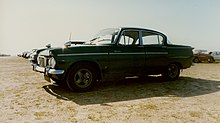Hillman Super Minx
| Hillman | |
|---|---|
|
Hillman Super Minx Mark II (1963)
|
|
| Super Minx | |
| Production period: | 1961-1967 |
| Class : | Middle class |
| Body versions : | Sedan , station wagon , convertible |
| Engines: |
Petrol engines : 1.6–1.7 liters (46–63 kW) |
| Length: | 4191 mm |
| Width: | 1595 mm |
| Height: | 1473 mm |
| Wheelbase : | 2565 mm |
| Empty weight : | 1016-1074 kg |
| successor | Hillman Hunter |
The Hillman Super Minx is a mid- size car that Hillman , a Rootes Group brand , built from 1961 to 1967. It is a slightly larger version of the Hillman Minx that was offered at the same time as the Audax models of the Minx.
Mark I.
The new model series was launched in October 1961 and gave the Rootes Group and especially the Hillman brand a greater presence in the middle class. Originally the Super Minx was supposed to replace the Minx, but it seemed a bit too big for this purpose. From May 1962 there was a station wagon from the vehicle originally only offered as a sedan and from June 1962 a two-door convertible. The convertible was never sold in significant numbers and so the last copy was made in June 1964, before the launch of the Super Minx Mark III.
The car was powered by a Rootes four-cylinder in-line engine with 1592 cm³ displacement with 62 bhp (46 kW) power, which was first offered in 1953 with 1390 cm³ displacement. The first Super Minx had a cast iron cylinder head, but it was replaced with an aluminum cylinder head on later models.
At the front, the Super Minx had independent suspension on double wishbones with coil springs and a stabilizer, while the driven rear axle was attached to longitudinal leaf springs. The cars had Lockheed drum brakes with a diameter of 229 mm and a brake booster all around . As was common at the time, the recirculating ball steering was not servo-assisted. A front bench seat covered with artificial leather ("Vynide") was part of the basic equipment, individual seats were available on request at an additional cost. The heater was also part of the basic equipment, but the radio was an optional extra. There were one- and two-tone paintwork. The manual four-speed gearbox was synchronized in the upper three gears and was operated with a center lever. A “Smiths Easydrive” automatic was available on request at an additional cost.
Mark II
One year after the start of production of the car, the Mark II version was presented in October 1962. There were no longer any grease nipples, the front drum brakes were replaced by larger disc brakes and the rear axle ratio changed. For cars with automatic transmissions, there was the Borg Warner 35 automatic instead of the Smith Easydrive.
Mark III
In 1964 the Mark III appeared with a modified body. Instead of the panoramic rear window, there were additional side windows behind the rear doors.
Mark IV
The Mark IV presented at the London Motor Show in October 1965 had an engine with increased displacement to 1725 cm³, which made 65 bhp (48 kW).
Related models

As usual with Rootes, the model was sold not only as the Hillman Super Minx, but also under other brand names.
The Singer brand offered the Singer Vogue from July 1961, four months before the Hillman Super Minx was launched. From 1963 there was the Humber Scepter from Humber . The names Singer Vogue and Humber Scepter were transferred to their successors ( Rootes Arrow ) after the Super-Minx-based models were phased out . The Humber Scepter was developed as a four-door successor to the Sunbeam Rapier , but was converted into a Humber before its launch, while the two-door Rapier was built unchanged until 1967. Unlike the Hillman and Singer versions, the Super Minx-based Humber Scepter retained its panoramic windshield, panoramic rear window, tail fins and roof structure until it was replaced in 1967 by a successor based on the Hillman Hunter.
The individual models differed slightly, with the Singer positioned slightly higher than the Hillman in the market. It came up with extras like twin headlights. The Humber was at the top of the line, reminiscent of the brand's old role as a manufacturer of upscale and luxury models. The shape of the scepter was reminiscent of that of the earlier, large Humbers. The Scepter Mark I and Mark Ia had a grille and front that differed little from those of the Singer Vogue, as well as a larger panoramic windshield, a lowered rear roofline, and larger tail fins. Actually, the Scepter was supposed to be a sports sedan until shortly before it was introduced as the Humber, hence its good performance compared to other Humber models.
The Humber was also available when it appeared with a more powerful 1.6-liter engine with 80 bhp (60 kW) and later with a 1.7-liter engine with 85 bhp (63 kW). Early 1.6-liter models had two Zenith downdraft carburetors, while the later 1.6- and 1.7-liter engines were equipped with a double Solex downdraft carburetor. The two Zenith carburettors were difficult to adjust. Other changes were a water-cooled intake manifold, modified valve timing and stronger valve springs to ensure that the valves close properly at high speeds. The later H120 engine with 107 bhp (80 kW) is based on swapping both units and looks very similar. It offers an increase in performance for a car that is already fast. The interior of the Scepter contained extensive instrumentation, such as a tachometer that reached up to 6000 rpm, a four-speed gearbox with center shift lever and self-deactivating overdrive . This overdrive for third and fourth gear was operated with a steering column lever and provided a total of six gear steps. The overdrive lock in the lower two gears could be switched off, which Rootes often did in competition vehicles, for example for rallies. In addition, the Scepter was equipped with a brake booster and - unusual for 1963 - front disc brakes with a diameter of 254 mm. The Mark I and Mark Ia models were not available with an automatic transmission, only the Mark II had an optional three-speed automatic transmission with kick-down function. The surcharge for this automatic transmission was lower than usual because the overdrive of the manually shifted car was no longer required.
There was also a Singer variant of the smaller Hillman Minx , the Singer Gazelle , but no Humber variant, with the exception of the Humber 80 in New Zealand . There was also the Humber 90 as a variant of the Super Minx. A derivative of the Minx for Humber would also have been atypically small for a Humber; in return there was a sporty derivative of the Minx for Sunbeam, the Sunbeam Rapier , but none of the Super Minx.
In addition to the Super Minx, Rootes Australia also produced variants of the Singer Vogue as Humber Vogue and Humber Vogue Sports from 1963 to 1966 .
At least six prototypes of the Humber Scepter were built with the same engine as the Sunbeam Tiger , a 4.7-liter V8 engine from Ford. There was no series production. It would have been a very powerful sports sedan with little competition in its class. A prototype was preserved.
successor
The Super Minx sedan and its Singer relatives were replaced by the Rootes Arrow models , which came out as Hillman Hunter and Singer Vogue for the London Motor Show in October 1966. However, the Hunter was initially only offered as a sedan and so the Super Minx station wagon remained in production until April 1967.
Individual evidence
- ^ A b David Culshaw, Peter Horrobin: The Complete Catalog of British Cars 1895-1975. Veloce Publishing, Dorchester 1997, ISBN 1-874105-93-6 .
- ↑ a b c d Used Car Test: 1962 Hillman Super Minx I. In: Autocar. Issue 124 (nbr 3647). Jan 7, 1966, pp. 20-21.
- ↑ a b c Used Car Test: 1964 Hillman Super Minx Convertible. In: Autocar. Issue 136 (nbr 3975). June 22, 1972, pp. 42-43.
- ↑ a b c d e Used Car Test: 1963 Singer Vogue Mark II. In: Autocar. Issue 128 (nbr 3753). Jan. 18, 1968, pp. 76-77.
- ↑ http://autominded.net/brochure/hillman/HillmannSuperMinx%201011.jpg
- ↑ a b c Used Car Test: 1963 Humber Scepter. In: Autocar. Issue 124 (nbr 3657). March 18, 1966, p. 585.
- ^ Gavin Farmer: Great Ideas in Motion, A History of Chrysler in Australia 1946-1981. Ilinga Books 2010, p. 365.
- ^ Australian History . Humber Enthusiasts Group Of NSW. AOL Hometown. ( Memento of April 30, 2006 in the Internet Archive ) Retrieved July 15, 2014.
Web links
- Rootes, Chrysler Europe, and Talbot (Hillman, Humber, Matra, SIMCA and Sunbeam) . Rootes-Chrysler.co.uk . Retrieved June 15, 2014.
- Photo of a Humber Vogue Mark II Automatic (1964) . Retrieved June 15, 2014.






